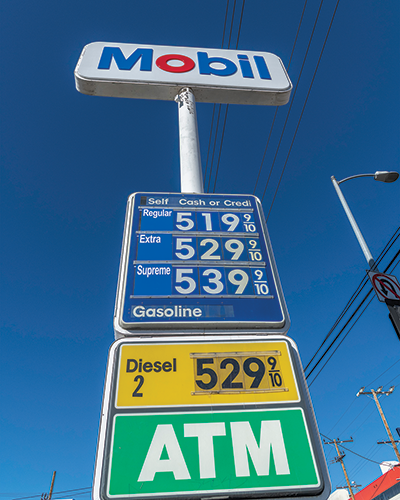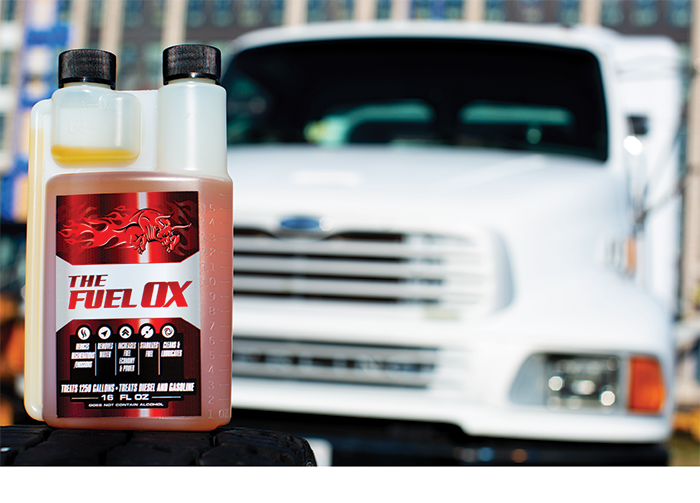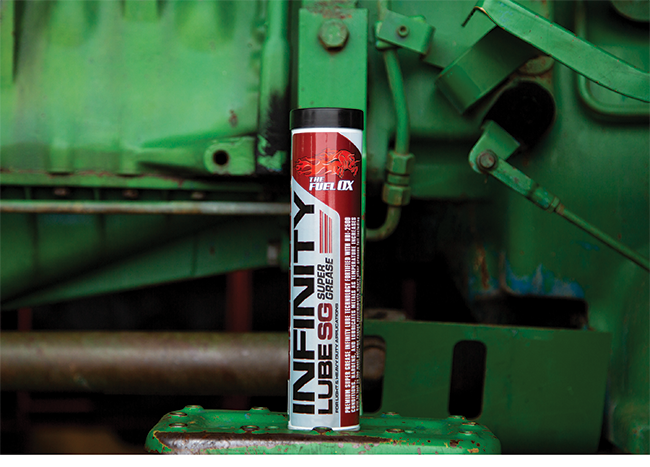Plant-based and environmentally safe fuel additive and lubricant products are helping customers more efficiently operate their industrial machines, heavy and long-haul trucks, cars, and other vehicles by using less fuel, resulting in fewer emissions that help customers have longer-lasting equipment—and most importantly, save money in maintenance costs, energy usage, and reducing equipment downtime while lessening the footprint we leave on the planet.
By Rand Taylor
Collection, transfer, and landfill operations have all experienced dramatic increases in business expenses due to the rising volatility of fuel costs. Prices were rising before Russia invaded Ukraine, but if you pair rising oil and gas prices with the ban on Russian oil imports, lingering supply-chain issues, and the U.S. inflation rate at an all-time high, the U.S. is seeing rising prices on everything from gas, to heating your home, to groceries, to much more. The fact of the matter is that these threats to our supplies created the perfect storm as they all converged at a time when demand is on the rise, and that situation created high prices across most aspects of everyday life.

Despite continued efforts to find new sources of energy, fossil fuels are hard to abandon as they have been the main source of energy in much of the world for the past two centuries. We use petroleum in the making of most products in our businesses and homes, and it helps create the electricity that powers them both. Petroleum is also used as a raw material in plastics, in many common household items like health, beauty products, as well as in the tires and the road asphalt we drive on. Frankly, it impacts hundreds of thousands of products in many industries.
Rising oil and gas prices also significantly impact manufacturing and trucking. From making or transporting what we eat, to where we work, what we wear, it is the transportation that helps us get around. Most—if not every part—of our lives is completely dependent on and intertwined with the energy provided by fossil fuels.
Since fossil fuels have been the dominant source of our energy, all of our systems—from production to infrastructure to transportation to residential—are set up for their use. Switching to another energy source requires completely rethinking much of the way we live and the way we understand energy. And that will likely take a significant amount of time.
Governments around the world are now engaged in efforts to ramp down greenhouse gas emissions from fossil fuels to prevent climate change. For an alternative energy source to be a viable substitution, it must replace fossil fuels’ efficiency, accessibility, and integration into society.

As this energy transition continues, there are still machines to power and gas to put in trucks and cars to keep life moving on all cylinders. Plant-based and environmentally safe fuel additive and lubricant products are helping customers more efficiently operate their industrial machines, heavy and long-haul trucks, cars and other vehicles by using less fuel, resulting in fewer emissions that help customers have longer-lasting equipment—and most importantly, save money in maintenance costs, energy usage, and reducing equipment downtime while lessening the footprint we leave on the planet.
How Are Rising Oil and Gas Prices Impacting Businesses?
From small businesses to large corporations, businesses today are feeling the squeeze from rising oil and gas prices and inflation. For many waste removal and recycling companies, fuel costs are some of the major expenses they incur. In fact, the U.S. EPA estimates that the average fuel economy was 4.4 mpg for heavy-duty trucks, which is approximately twice the previously reported value for residential trash collection trucks. Considering the volatility in gas prices, that makes it hard for any business to estimate its monthly expenses..
Oil and gas are also critical to the economy for manufacturing and shipping, and almost no industry is immune. Manufacturers of products and goods are not only paying more to develop their products, but it now also costs more to transport them to retailers. Think about the costs for what it takes to get a cargo ship with various goods to the U.S. We know that about half the cost for powering a cargo ship is the fuel needed to get across the ocean. Back in mid-March, nationwide wholesale diesel prices had gone up 50 cents per gallon. Those high prices impact the cargo ships and the land-based trucks that carry goods from the ship to the shelves in the U.S. This explains why you may see increased shipping costs from Amazon, FedEx, UPS, and the U.S. Postal Service trucks that bring goods to your door—they need to fuel up, too.
Once the goods reach the shelves, retailers do not have much of a choice except to pass that increased cost on to customers. They may choose to ease some of that cost in the short term if they feel consumers will not tolerate the price increase, while gas and groceries are still costing more.
Trucking, waste removal and recycling, shipping, and individual drivers are not the only ones paying more for fuel. Jet fuel prices have also skyrocketed, with prices of flights increasing. It is estimated that the cost to fill a 777-300 recently went up by $22,600. That could ultimately impact a lot of people who are taking summer vacations.
Taxi, rideshare, and delivery drivers also have to fill up their tanks. Lyft, Uber, Door Dash, and others in the gig economy are helping to alleviate this pain at the pump with temporary gas surcharges and even increasing driver’s base pay.

What Can Businesses Do to Save Money?
Businesses and consumers must manage the impact of higher prices through improved fuel efficiency with lower emissions. Industry has always struggled to find a way to significantly reduce the costs of maintaining its capital equipment, including vehicles and heavy machinery. Friction and inefficient combustion are the greatest destroyers of machine efficiency and longevity. Here are a couple of tips for how to get the most out of your business equipment:
1. Routine maintenance is critical now more than ever, especially with steep increases in shortages for parts and lubricants. A good rule of thumb is, if you take care of your equipment, that equipment will take care of your business. For those that wait until something is broken, it may take five to seven months for parts arrive. For heavy equipment and transmissions, some customers have been waiting for more than a year for replacement transmissions. These delays could sideline a company, especially a waste management, recycling or trucking company.
2. Make sure you use fuel additives and lubricants to get the most out of your equipment. Effective fuel additives and lubricants not only extend the life of equipment, but also reduce emissions, fuel consumption, maintenance and replacement parts costs, and even give you longer oil life and cleaner used oil. Fuel additives can save 7 to 10 percent in fuel costs while cutting emissions by 60 percent. When fuel additives are used in combination with machine lubricants, friction can be reduced by as much as 700 percent. This powerful duo helps with longer lasting equipment, reduced maintenance costs, fewer parts replacements, resulting in less machine down time and fuel usage.
What Can Consumers Do to Save Costs?
As many business owners have growing concerns for higher gas prices, these owners are consumers too, who still have to fuel their personal cars—in essence, a “double whammy.” According to the Bureau of Labor Statistics, 65 percent of Americans are living paycheck to paycheck. That is a lot of pain at the pump. AAA also reports that 6 in 10 drivers have adjusted their driving habits as gas prices reached over $4 in March 2022—an all-time high, and with diesel fuels soaring to more than $5 in some parts of the country. The challenge is that 18 percent of these drivers said their wages have not kept up with the rising gas prices and overall increase in costs.
However, there are things we all can do to save at the pump Actually, the way we drive can have a real impact on your vehicle’s fuel efficiency. Consider these tips:
- Many people still drive with one foot on the brake and one foot on the gas. This can reduce fuel efficiency by 30 percent. On average, if you changed this driving habit, you could save $1.42 a gallon at today’s gas prices.
- Do not speed. Fuel economy peaks at around 50 mph on most cars. Reducing highway speeds by 5 to 10 mph can increase fuel economy by as much as 14 percent, according to AAA.
- Do not brake hard or aggressively accelerate as this burns gas faster.
- Turn off your A/C and roll down the windows. Enjoy the fresh air.
- Keep up with vehicle maintenance and do routine inspections.
- Make sure your tires are properly inflated. If your tires are low, you could decrease your gas mileage by about 5 mpg. Make sure you are using the numbers listed on the inside of your driver’s side door instead of the ones on your tires.
- Travel light. Take anything you do not need out of your vehicle. For every 100 pounds you carry around, you lose 1 to 2 percent in fuel efficiency, or 8 cents a gallon. If you are not using those car racks on the top of your car, then take them off until you need them. These car racks could be causing you to spend more than 25 percent more in gas.
- Fill up more often than once a week. AAA recommends filling up once your car gets to a quarter-tank, but that does not mean you have to fill it all the way to the top every time. Fill it another quarter and a half to avoid constant sticker shock.
- There are plenty of apps to help you find cheap gas in your area. And when you see cheaper gas, buy it if you can.
None of us can control the volatile high oil and gas prices, or even inflation—they are not going to be solved anytime soon. However, do not let what is out of your control interfere with all the things you can control. What is most important is how you react and take action to make your business more profitable.
There are still a lot of ways for waste removal and recycling companies to save money, time and resources. Think about your routine maintenance now more than ever, consider using fuel additives and lubricants to extend gas mileage and the life of your equipment, and consider adjusting your fleet’s driving habits—all of these can make a big difference. Once the economy starts to improve, we will all be relieved to put these challenging times behind us. The key is to make sure you don’t lose the lessons learned along the way so your business continues to thrive well into the future. | WA
Rand Taylor is co-founder and CEO of the Industrial Sustainability Group (ISG), makers of Fuel Ox® fuel additives and the Infinity Lube™ product lines with distribution on multiple continents. For nearly a decade, the company has created the most environmentally sustainable fuel and lubricant products in the industry. For more information, e-mail at [email protected] or visit www.FuelOx.com.
